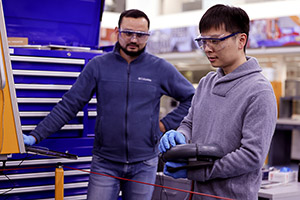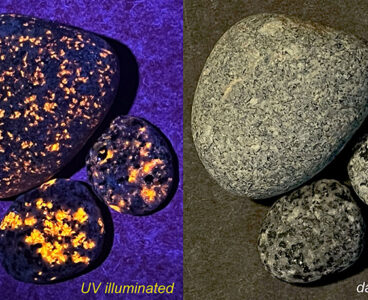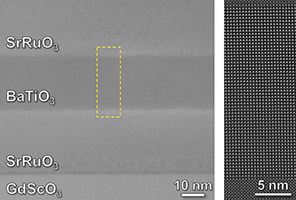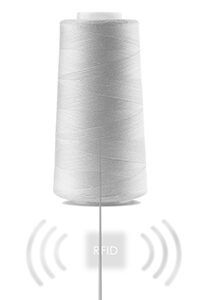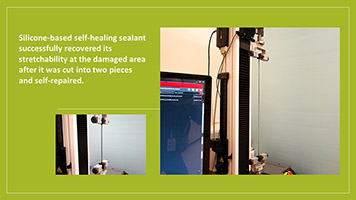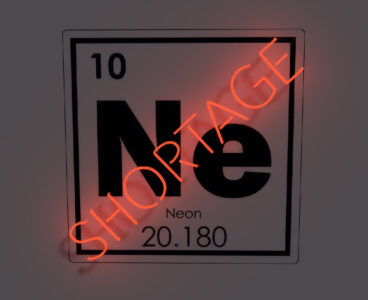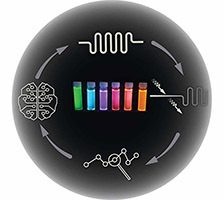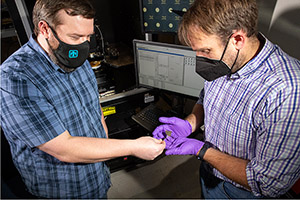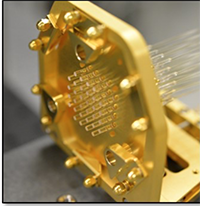Elkem Silicones developed a new syntactic silicone foam that provides reliable thermal and electrical insulation in electric vehicle (EV) batteries. This low-density, room-temperature curing foam protects battery cells against propagation and thermal runaway to other cells, and thermal stability to protect against harsh chemical environments. Safety and reliability are critical parameters when designing EV battery…
Overcoming common barriers to the materials science lab of the future
By Chris Farrow, Vice President, Materials Science Solutions at Enthought As demand increases and competition becomes tighter for functional materials, such as electrolytes for batteries, consumables for semiconductor manufacturing, and functional plastics, materials and chemical companies are competing to continuously innovate and differentiate themselves in new and existing markets. Despite the urgency, 60-70% of scientists’…
Driving process safety with better data in chemical engineering
By Jim Harper, Senior Product Manager, Elsevier Safety and risk mitigation are high on the agenda for professionals in the energy, petrochemical, chemicals, and construction industries. Headlines such as the Deepwater Horizon oil spill in 2010, the Fukushima nuclear disaster of 2011, or the Grenfell Tower fire of 2017, serve as bleak reminders of the…
Insects offer new ideas on materials use, structure strength via 4D time-lapse imaging
From Purdue University, Brian Huchel Purdue University engineers and entomologists are making some sweet discoveries about how honeybees build and structure their honeycombs, which could lead to new fabrication techniques taken from the buzzing builders. Nikhilesh Chawla, the Ransburg Professor of Materials Engineering at Purdue, is one of the first to use four-dimensional (4D) imaging…
Plastic to metal, steel to aluminum — the future of welding and lightweight vehicles
Making vehicle structures out of a combination of metals and plastics could make them dramatically lighter, stronger, safer, and more environmentally friendly than the all-steel or all-aluminum approaches that dominate today. But how to join all those materials together quickly and cheaply has been a sticky problem. A University of Michigan lab is developing solutions.…
DuPont debuts Micromax brand for microcircuit and component materials products
DuPont announces the launch of a new brand, Micromax, that will encompass the products formerly under the Microcircuit and Component Materials brand. Micromax products are used in a wide variety of electronics applications — from automotive, passive components, and 5G communications to healthcare and consumer goods. “Micromax aims to be the leading brand for electronic…
DOWSIL Immersion Cooling Technology improves data centers’ sustainability and efficiency
Dow has introduced DOWSIL Immersion Cooling Technology, a next-generation solution for cooling hyperscale cloud and enterprise data centers with optimized efficiency and sustainability. Award-winning DOWSIL Immersion Cooling Technology offers a revolutionary approach to thermal management and sustainability for fast-growing data centers in a new era of high-speed, high-volume data communications. Winner of R&D 100 Award…
New additive technology protects paper products from food liquids and oils
AGC Chemicals Americas introduces FibraLAST non-fluorinated sizing additives that protect paper products from both water and food oils. These patent-pending grades are designed as alternatives to traditional sizing products. This new barrier technology is suitable for molded, formed fiber and cardboard products such as fast-casual bowls, plates, containers and pizza boxes. FibraLAST grades prevent the bleed-through…
Glowing rocks, a new sport, and what we can learn about different approaches
Designer materials to keep plastic out of landfills
From Berkeley National Lab, By Alison Hatt Scientists have designed a new material system to overcome one of the biggest challenges in recycling consumer products: mixed-plastic recycling. Their achievement will help enable a much broader range of fully recyclable plastic products and brings into reach an efficient circular economy for durable goods like automobiles. We…
Submit your design for the 2022 Packaging Innovation Awards
Dow is once again looking for the most innovative packages in the world. The entry period for the 2022 Packaging Innovation Awards is now open at www.dow.com/packagingawards. First launched over 30 years ago, the Packaging Innovation Awards honor the best, most innovative designs in the packaging industry. Past winners have redefined categories and challenged the…
What are nanoparticles?
Nanoparticles are engineered particles of between one and 100 nanometers in diameter, a size known as the nanoscale. To put this into context, a nanometer (nm) is one billionth of a meter, and the distance between individual atoms in a solid is between 0.1 nm and 0.4 nm. Nanoparticles therefore range in size from tens…
New Ultrathin Capacitor Could Enable Energy-Efficient Microchips
From Berkeley Lab, By Rachel Berkowitz The silicon-based computer chips that power our modern devices require vast amounts of energy to operate. Despite ever-improving computing efficiency, information technology is projected to consume around 25% of all primary energy produced by 2030. Researchers in the microelectronics and materials sciences communities are seeking ways to sustainably manage…
Advanced fluoropolymer materials excel in harsh oil recovery environments
AGC Chemicals Americas will feature Fluon+ mPLASTICS, AFLAS FFKM PM-3500 perfluorinated elastomer, AFLAS 400E or 600X FEPM fluoroelastomer grades and Fluon+ Compounds at the Oil and Gas Polymers Engineering event June 21-22, at the Hilton Houston Post Oak Hotel in Houston. These materials are widely used in equipment components that operate in severe oil and…
R&D 100 winner of the day: RFID Yarn: Overcomer for 5 Major Durability Test
Taiwan Textile Research Institute (TTRI) has developed the world’s first Radio-Frequency Identification (RFID) yarn, which makes it full of applicative possibilities. RFID Yarn passes five major durability tests: anti-laundry, anti-acid, anti-alkali, anti-high temperature and anti-roller pressure. TTRI initiated RFID Yarn Technology Industry Alliance, to set up testing standards for newcomers. To achieve RFID Yarn, the…
R&D 100 of the day: Autonomous Self-Healing Sealant
Oak Ridge National Laboratory’s Autonomous self-healing sealants self-repair microcracks and cuts, recover mechanical properties and adhere well to dusty surfaces. They are formulated by mixing a low-cost additive into commercial sealants according to a process developed at ORNL. The treatment increases sealant lifetime and energy savings by lowering air and water leaks in buildings. Even…
Why there’s a neon shortage — and why it matters
By Mark Jones In a normal world, vodka, nickel, palladium, and neon would have nothing in common. In our current world, after the Russian invasion of Ukraine, they do. All are currently experiencing supply chain disruptions due either directly to the fighting or to sanctions. Nickel and palladium come from mines. Russian mines produced about 10%…
Seeing more deeply into nanomaterials
From Brookhaven National Laboratory: From designing new biomaterials to novel photonic devices, new materials built through a process called bottom-up nanofabrication, or self-assembly, are opening up pathways to new technologies with properties tuned at the nanoscale. However, to fully unlock the potential of these new materials, researchers need to “see” into their tiny creations so…
R&D 100 winner of the day: GRSR
Nano and Advanced Materials Institute (NAMI) has invented a toxin-free, anti-biofouling silicone for its biosafety and long-lasting germ-repellent efficacy with a permanent PEGylated repelling surface to impede bacterial growth. In contrast to conventional leachable germ-killing biocides, this novel material neither causes antimicrobial resistance nor disturbs microbiome balance by killing beneficial microorganisms. Sustained, toxin-free, anti-biofouling silicone…
R&D 100 winner of the day: AgriTraxx AirCore Gauge Tires
The AgriTraxx AirCore, Superior Tire & Rubber Corp., is a high-performance polyurethane gauge wheel tire intended for No-till agriculture applications. No-till is a more efficient and sustainable farming method saving thousands of gallons of diesel fuel per farm, per year while producing greater crop yields over conventional till methods. The tire uses an innovative design…
Curling stones: Circular, but not part of the circular economy
‘Self-driving’ lab speeds up research, synthesis of energy materials
By Milad Abolhasani, NCSU and Matt Shipman, NCSU Researchers from North Carolina State University and the University at Buffalo have developed and demonstrated a ‘self-driving lab’ that uses artificial intelligence (AI) and fluidic systems to advance our understanding of metal halide perovskite (MHP) nanocrystals. This self-driving lab can also be used to investigate a broad…
Record-breaking, ultrafast devices step to protecting the grid from EMPs
From Sandia National Laboratories Scientists from Sandia National Laboratories have announced a tiny, electronic device that can shunt excess electricity within a few billionths of a second while operating at a record-breaking 6,400 volts — a significant step towards protecting the nation’s electric grid from an electromagnetic pulse. The team published the fabrication and testing…
R&D winner of the day: Monolithic Fiber Array Launcher
Fiber arrays are used for constructing optical phased-array lasers, which are used in high-power industrial applications and beam steering for lidar. MIT has developed and built an all-glass, monolithic fiber array that is smaller and more robust than standard arrays. Fiber arrays are used for constructing optical phased-array lasers that can enable power scaling and…
R&D 100 winner of the day: Layered-Rocksalt Intergrowth Electrode Materials for Next-Generation Li-ion Batteries
The $30 billion-plus global Li-ion battery market is expected to double in the next five years. Improved cathode materials will enable Li-ion batteries to operate reliably at high capacity and high voltage over repeated cycles without sacrificing performance, safety or cost. However, existing options are hindered by material and performance degradation at high voltage, limiting…





